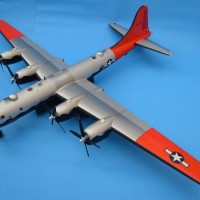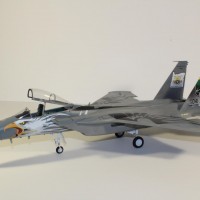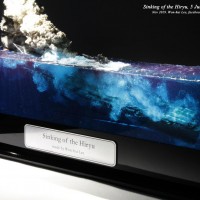Revell 1/72 He-177A-5
The origins of the idiosyncratic He-177 “Greif” can be traced in the mid 1930s, where Generalleutnant Walther Wever, a longtime advocate of strategic bombing, pressed the Luftwaffe to develop a dedicated long-range bomber for the role of attacking the Soviet Union's factories in the Ural Mountain area. This concept was received with significant skepticism amongst many senior officials within the Luftwaffe, so, by 1936, only two, rather uninspiring "Ural bomber" designs had emerged, the Dornier Do-19 and Junkers Ju89.
Wever continued to press for new designs for this role and the Reichsluftfahrtministerium (RLM) finally released a new specification, named “Bomber A”, calling for a significantly more advanced design with speeds higher than those of contemporary fighters, longer range and larger payloads. The specification was issued on June 3, 1936, the same day that Wever was killed in an air crash and the design losing its only politically powerful champion.
On 2 June 1937, Heinkel Flugzeugwerke received instructions to proceed with construction of a full-scale mock-up of its so-called Projekt 1041 Bomber A. To meet the required specifications, Siegfried Günter, Ernst Heinkel's chief designer, had to employ several mechanical and aerodynamic revolutionary features, in order to increase performance and decrease weight.
In order to decrease drag, it was decided to go with a twin engine design, which, due to the non-availability of such powered engines, was to be materialized by using paired DB-601 engines in tight nacelles. The resulting DB-606 powerplants proved in practice significantly problematic, their main issues (among many others) being their tendency to overheat and catch fire during flight.
The envisaged “Surface Evaporation Cooling” that used nacelle panels as cooling surfaces in order to minimize drag, proved also inadequate, resulting in using normal annular radiators within the nacelles which notably increased drag. Same saga with the envisaged three cockpit-controlled remote gun turrets, with the available technology proving insufficient to keep pace with the specific requirements, resulting in design modifications to accommodate larger and heavier manned positions, meaning weight increase as the fuselage had to receive structural strengthening in several locations. The wings' strength would also prove inadequate in practice, resulting in costly and extensive strengthening, further increasing the aircraft's weight.
What was already a problematic situation was to become worse, as, by the end of 1937, Oberkommando der Luftwaffe dictated that the plane should be able to perform 60° dive bombing and safely pull out of the dive. This meant additional strengthening which had a deleterious effect on the aircraft's weight. Heinkel said that this requirement would never be effectively performed by the plane and he was right, with the constant increases in the loaded weight imposing overstressing forces to the already overweight airframe.
The immense increase of the type's weight during development meant that it would need equally strengthened (meaning bigger) main undercarriage that would have to fit in the crammed nacelles and adjacent wing areas where there was practically no room. Heinkel engineers had to resort to extremely complex twin-leg designs that would hang under the nacelle at a significant front caster angle and would individually retract at each side of the nacelle/wing area in an equally complex manner. Needless to say, the system was a maintenance nightmare, making even simple jobs like a tire change a time consuming exercise.
The type's operational history was largely affected by the aforementioned technical difficulties. Not only it had to enter service not earlier than 1942, but also it was still far from operational, having to deal with significant problems, mainly with the engines and airframe strength. Those problems were never satisfactorily addressed till the end of the war, thus dooming the bomber, with its successful missions not being that many.
One of the special weapons the type carried was the Fritz X guided anti-ship glide bomb, the world's first precision guided weapon deployed in combat and the first to sink a ship in combat. While the weapon itself was lethal when used effectively, it seems that it was not so successful with the Grief, with reports stating that the aircraft had to "toss" the bomb slightly, climbing and then descending, to keep it in view ahead.
The plane was tested with a number of experimental weapon loads as well. These included a pair of limited-traverse 30 mm MK 101 cannons or a 50mm or even a mammoth 75mm Bordkanone in the extreme front of a dramatically enlarged “Bola” ventral gondola, or 33 obliquely mounted 21 cm (8¼ in) caliber rocket mortar tubes. These configurations never seemed to have been used operationally.
In common with most piston-engined German bombers, the type was grounded from summer 1944 due to the implementation of the Emergency Fighter Program as well as due to the Allied bombing of German fuel production facilities. All in all, 1169 examples were built.
Definitely imposing but ultimately a failure, the Greif was an ambitious, aggressive project, with its design requirements standing at a level higher than that of the available practical technology, with the subsequent requirement for dive bombing making sure that the plane would never have a chance of maturing and becoming effective.
A good number of us would argue that the mid 90s to mid-00s were amongst Revell's best years, as the company came up with many nice new toolings of significant modeling subjects (focusing, among others, on German WWII, including less known types and even Luft46 examples), offered at very good prices. One of them certainly was their excellent 1/72 He-177 that hit the shelves in 2000 at an unbelievably low price (less than $20).
https://modelingmadness.com/review/axis/luft/he/pen177.htm
Happy Modelling!


















Hi Spiros
Great work! That really is a well realised model. A very impressive sumarisation of the history of this 'Molesworth's Horse' as well.
Thank you kindly, my friend @christopher!
Great work, Spiros, and I really liked the historical information you presented, much of which I hadn't known before.
Thanks a lot, my friend @seawinder!
This is an impressive build, Spiros @fiveten
Both in dimensions and the way it looks.
Excellent result and very interesting topic.
Thanks so much, my friend @johnb!
Very impressive work. I especially like the subtle shading on the lower side. The camo on top is excellent too.
Thanks so much, my friend @guitarhack5!
Very, very nice paintwork, Spiros @fiveten, i like the camouflage especially. I like how the dark green pattern is consistent in size and shape!
Thanks a lot, my friend @fxrob!
Yes indeed, a very impressive model along with your well researched background info on this beast, Spiros @fiveten. You’ve done it again!
Thank you kindly, my friend @eb801!
Another wonderful article and model, Spiros @fiveten! I enjoy each and every one of your articles here, and each beautifully built model too! Great work from a great forum member!
I enjoy each and every one of your articles here, and each beautifully built model too! Great work from a great forum member! 
Thank you so much for all kind words, my friend @garybrantley!
A dive Bomber? And the design had to be '2 engines' since no 4 engines were being accepted for the specifications - I shake my head in wonder. The more you read about the constraints on the specification design the more you wonder how it could work at all.
Great result with this great kit, Spiros. Very nice work on the camouflages scheme.
Thanks a lot, my friend @georgeswork! What an idiosyncratic machine the Greif was!
What a beast! great job!
Thank you kindly, my friend @jsummerford!
Spiros,
Interesting article and a easy read. Great way to pull in the reader and set the hook for another exceptional model. The Germans did make a conventional four engined Grief with four nacelles the He 277. The British found out that the two engined Manchester was a bust and added two engines to create the Lancaster. They were far more nimble in their thinking than the Germans. Had Germany started out with He-277 the war would have taken a different direction. A real treat. Two thumbs up.
Thank you kindly, my friend @stephen-w-towle! I totally agree, the He-277 would have been a total success.
Really nice work on this and an excellent result, Spiros (@fiveten).
Thank you so much, my friend @tcinla!
Spiros @fiveten, excellent work and the overall paint finish is awesome! Also great read as usual.
Thanks so much, my friend @v1pro!
Beautiful modeling, Spiros, and excellent painting and shading. But please: GREIF, G-R-E-I-F, which means the mythological griffin in English.
Thanks a lot, my friend @brummbaer!
Oh my! Just noticed after all these years! Thanks for this also! Onto correcting now!
Sharp work and outstanding camo scheme Spiros!
Thanks a lot, my friend @dtravis!
Well done, Spiros. Nice finish. Looks big even at 1/72
Thank you very much, my friend @gwskat! Yes, it's big, especially span wise.
Spiros, this is a masterpiece. Well done!
Thank you so much, my friend @bapowellphys!
Lovely Greif!
Thank you kindly, my friend @magoo!
Thank you for the article and cool model, Mr. Pendedekas. You wouldn’t happen to have any info/references on the differences between the He-177 A-1 and the A-5 would you? I’m backdating an Ancient Airfix He-177 kit.
Thanks!
Thanks so much, my friend @carel!
I am by no means expert, but what I was able to figure out was that the A-1 had mainly shorter, fuselage and LONGER undercarriage oleo legs. Those seem to have been the major visual differences.
Apart form that, I was not able to figure out if the "Bola" gondola was shorter (going less aft) on the A-1, too (its aft end had been lengthened by 1.2 m to the A-3/R-4 version to provide room for the FuG 203b Kehl III missile-control equipment, instead of the usual rear-fuselage mounting location, however I am not sure if it was kept longer on my A-5...).
The engines were also different versions, but this might not be visible.
Finally, the assortment of MG guns seems to have been different (different MG gun versions), but those were also field modified in many machines.
Looking forward to your Greif!
This really turned out excellently ! The paint is especially nice… A+ work Spiros @fiveten !
Thanks so much, my friend @ssgt!
Excellent result and interesting article on the development if the He-177, Revell produced some great stuff during that period of time.
Thanks my friend @chasbunch! Indeed, those were among Revell's better days.
Good article and great paint job, Spiros!
Thanks a lot, my friend @robgenev665!
Great job as always, Spiros. The airbrushing of the camo is very subtle. Panel lines and weathering are very nice as well. That must be a pretty big model even at 1/72.
Thank you kindly, my friend @coling! Yes, it is quite big.
Hi Spiros @fiveten,
What an excellent build and ditto paint job. I guess the camo scheme has been applied freehand? Very impressive model. The background read was very informative, thanks for that. Luckily the real thing was not that successful back then. Cheers.
Thanks a lot, my friend @alfred! Yes, the top pattern was freehanded. And, yes, thankfully, the real thing was not that successful.
I started building this model once and never finished it after I got married. It's an impressive build and looks really cool in your design. The additional information is also very interesting.
Thank you kindly, my friend @milantesar!
Excellent result! That scheme looks really good on the Greif. Well done.
Thank you very much, my friend @gkittinger!
Smart work, Spiros... the Revell kit is a very nice model with a lot of good detail both internally and externally. Your work paid off with this lovely finish.
Thank you very much, my friend @paulh!
Great job mate. Love the camo.
Thanks a lot, my friend @paulwoodyvanacker!
Nicely done and presented Spiros (@fiveten)
Thanks my friend @kalamazoo!